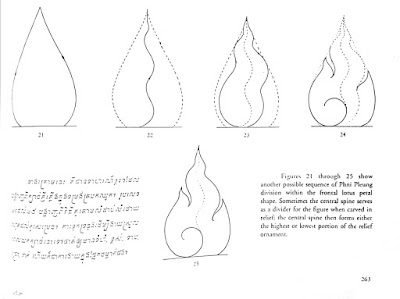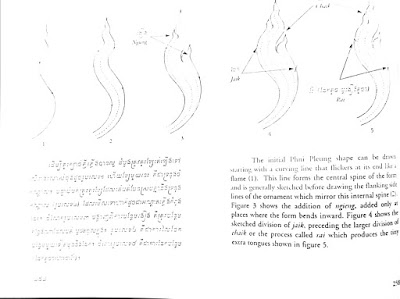ihcm Oucen RAicndradevl whose statue in the form at the goddess Cam :5 ex?‘ Med .2: the mu
if scum — belorc leaving Hariharalaya to rside m Anglia, m a new aerial named axe.- h‘m hashes.
H harapura
At the time the royal temple stood in the cemreol'Yashodharapura nuts :25 fire Nndultrg‘x
I elevated on a sandstone pyramid. on the hill oi Phnorn oBakheng This swk‘LceIZ) 3‘1th limr’k‘
echoes Mount Meru. the abode ofthe gods and the ans ofthewodd whose ime 5:27:11 its are more~
sented by the live sanctuaries The sanctuaris house hnga, since for follow-e5 of 5mm exenth m: H
Shiva The presence 0! the gods at the heart 0! the kingdom was supposed to ensure that the km:-
dom remained Indestructible
During the reign of Yashovarman 5 sons. one oi his brothers—m-lau- secedeo‘ and rounded a
a capital some lilty miles away. on the site 0! Koh Ker He had some mater mnurrents burl: at Koh
v Ker. including the Prasat Thorn, the 'Great Temple' in 95-5. a nephew otYashosaman l, Rilendu
varman ll [944—968) reinstated the capital atAngtor The reign of Rarendravannan ll mtnexx‘z‘d ex-
tensive reforms in the administrative organisation of the kingdom At the same time the reerTmble
buildings ol the Temple oi Eastern Mebon dediated to the memory or hrs ancestors and the Rom!
Temple ol Pre Rup were founded. and the pyramid oltheTemple ol Phimanakas in the Royal p3,
lace was erected, The building of the gopura. the pavilions sluated at the entrance of the enclosure
of the Royal Palace. must have been undertaker: Matter-aids indeed the superstructures ct
these gopura echo the decoration on the pinksa'idstone Banteay Ste: temple founded in 007 by a
high Brahman dignitary, cousin to the king Banteay Srei. in its forest setting is one of the most
poetic worls of Khmer arts The museum horses Shiva. the principal idol of this temple tenderly
holding Uma on his knee
Al the beginningolthe eleventh wintryfilkmman l iiOlO—IO'SOI became hng atter detea»
ting In battle his rival to the throne, who might have been the Founder oi the la Kéo temple The
Cambodian monarchs never forgot the temple of Phu Wat. the sanctuary of their ancestors at the
time oi Chenla. sflryavarman i built glorious monumentsa the foot of the mountain and rounded
the Preah Vihear Temple at theedge oi the Bengt pineal: where he erected the statue ol the dn l:
nity of Phu Wat the 'Benevolent lord“. Healsaaarrpleted the buildngof the Temple of Humans-
has in the Royal Palace atAngkor:
After he died. his eldst son built the trad BaphOon Mantle south of the Royal Palam
Small has-reliefs illustrating episodes from the Rina-yam and the Mahabharata decorate the walls
' of this temple The scens relate thedeedsolkémaand Krishnaandthevarious themationsoflx-
" shnu. Here and there. the anotions of thesoulptoremera. such as in the scene tn which Rama do
Iicately touchs the shoulderofthe crying monkey Hagtogue bin m Atom-id me sum time m
a temple in the centre ofthearfifidal lal'etotheieadhnflu, an“! m statue ontshnu
reclining. majestic and serene. aslhoughwakingrna “SIM“ erected The bus! of the
: god.whlchhasremainedlnlaa.isoneolthewvelsdtltem
r. In “B. alter the binhota rte-dynasty. Hum nuns-15mm power by
defeating two kings SOryavar-man II is EmshhllficdteWedir-igiuwa dedicated to
: \nshnu. his favourite deity. which is probahtythe most harm creation of mm“ architecture
Bas-rellels of bards. mythlal legends. souls dhea‘ensand hells tunes oi the king himself at
court and setting outon militaryexpetfifionsnhrmlusam mmh- unbl-
dedbeforetheeysofVishnu'sdevotees Flo-evenduirgmauuwtedatnckonwhat isnovviet
nam. Sflryavannanwasabandonedbytheaiamsudmnedmdlem Msparhedoflpmtnc.
tedwars bemen the Khmers andthedtans Thedateolainmsm is not known. Like
hlspredm hemmanoahmsmmmthemummmm
Mththatofthezodhewishedtobeifintifiedvflx t
Alterthe deathdSflmvarmnfllueflb-dahodtledpedodmm W\W~
man Iiwas murdered In li65byamrpetandln [IanhlllotheChammdvassao




















































